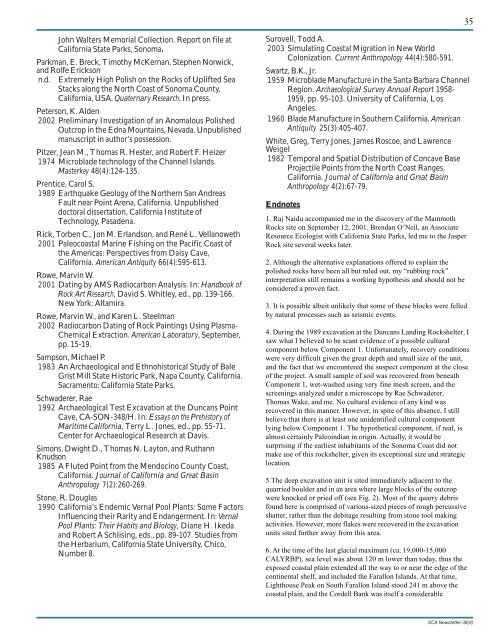Mammoth Rub Update - Society for California Archaeology
Mammoth Rub Update - Society for California Archaeology
Mammoth Rub Update - Society for California Archaeology
You also want an ePaper? Increase the reach of your titles
YUMPU automatically turns print PDFs into web optimized ePapers that Google loves.
John Walters Memorial Collection. Report on file at<br />
Cali<strong>for</strong>nia State Parks, Sonoma.<br />
Parkman, E. Breck, Timothy McKernan, Stephen Norwick,<br />
and Rolfe Erickson<br />
n.d. Extremely High Polish on the Rocks of Uplifted Sea<br />
Stacks along the North Coast of Sonoma County,<br />
Cali<strong>for</strong>nia, USA. Quaternary Research. In press.<br />
Peterson, K. Alden<br />
2002 Preliminary Investigation of an Anomalous Polished<br />
Outcrop in the Edna Mountains, Nevada. Unpublished<br />
manuscript in author’s possession.<br />
Pitzer, Jean M., Thomas R. Hester, and Robert F. Heizer<br />
1974 Microblade technology of the Channel Islands.<br />
Masterkey 48(4):124-135.<br />
Prentice, Carol S.<br />
1989 Earthquake Geology of the Northern San Andreas<br />
Fault near Point Arena, Cali<strong>for</strong>nia. Unpublished<br />
doctoral dissertation, Cali<strong>for</strong>nia Institute of<br />
Technology, Pasadena.<br />
Rick, Torben C., Jon M. Erlandson, and René L. Vellanoweth<br />
2001 Paleocoastal Marine Fishing on the Pacific Coast of<br />
the Americas: Perspectives from Daisy Cave,<br />
Cali<strong>for</strong>nia. American Antiquity 66(4):595-613.<br />
Rowe, Marvin W.<br />
2001 Dating by AMS Radiocarbon Analysis. In: Handbook of<br />
Rock Art Research, David S. Whitley, ed., pp. 139-166.<br />
New York: Altamira.<br />
Rowe, Marvin W., and Karen L. Steelman<br />
2002 Radiocarbon Dating of Rock Paintings Using Plasma-<br />
Chemical Extraction. American Laboratory, September,<br />
pp. 15-19.<br />
Sampson, Michael P.<br />
1983 An Archaeological and Ethnohistorical Study of Bale<br />
Grist Mill State Historic Park, Napa County, Cali<strong>for</strong>nia.<br />
Sacramento: Cali<strong>for</strong>nia State Parks.<br />
Schwaderer, Rae<br />
1992 Archaeological Test Excavation at the Duncans Point<br />
Cave, CA-SON-348/H. In: Essays on the Prehistory of<br />
Maritime Cali<strong>for</strong>nia, Terry L. Jones, ed., pp. 55-71.<br />
Center <strong>for</strong> Archaeological Research at Davis.<br />
Simons, Dwight D., Thomas N. Layton, and Ruthann<br />
Knudson<br />
1985 A Fluted Point from the Mendocino County Coast,<br />
Cali<strong>for</strong>nia. Journal of Cali<strong>for</strong>nia and Great Basin<br />
Anthropology 7(2):260-269.<br />
Stone, R. Douglas<br />
1990 Cali<strong>for</strong>nia’s Endemic Vernal Pool Plants: Some Factors<br />
Influencing their Rarity and Endangerment. In: Vernal<br />
Pool Plants: Their Habits and Biology, Diane H. Ikeda<br />
and Robert A Schlising, eds., pp. 89-107. Studies from<br />
the Herbarium, Cali<strong>for</strong>nia State University, Chico,<br />
Number 8.<br />
Surovell, Todd A.<br />
2003 Simulating Coastal Migration in New World<br />
Colonization. Current Anthropology 44(4):580-591.<br />
Swartz, B.K., Jr.<br />
1959 Microblade Manufacture in the Santa Barbara Channel<br />
Region. Archaeological Survey Annual Report 1958-<br />
1959, pp. 95-103. University of Cali<strong>for</strong>nia, Los<br />
Angeles.<br />
1960 Blade Manufacture in Southern Cali<strong>for</strong>nia. American<br />
Antiquity 25(3):405-407.<br />
White, Greg, Terry Jones, James Roscoe, and Lawrence<br />
Weigel<br />
1982 Temporal and Spatial Distribution of Concave Base<br />
Projectile Points from the North Coast Ranges,<br />
Cali<strong>for</strong>nia. Journal of Cali<strong>for</strong>nia and Great Basin<br />
Anthropology 4(2):67-79.<br />
Endnotes<br />
1. Raj Naidu accompanied me in the discovery of the <strong>Mammoth</strong><br />
Rocks site on September 12, 2001. Brendan O’Neil, an Associate<br />
Resource Ecologist with Cali<strong>for</strong>nia State Parks, led me to the Jasper<br />
Rock site several weeks later.<br />
2. Although the alternative explanations offered to explain the<br />
polished rocks have been all but ruled out, my “rubbing rock”<br />
interpretation still remains a working hypothesis and should not be<br />
considered a proven fact.<br />
3. It is possible albeit unlikely that some of these blocks were felled<br />
by natural processes such as seismic events.<br />
4. During the 1989 excavation at the Duncans Landing Rockshelter, I<br />
saw what I believed to be scant evidence of a possible cultural<br />
component below Component 1. Un<strong>for</strong>tunately, recovery conditions<br />
were very difficult given the great depth and small size of the unit,<br />
and the fact that we encountered the suspect component at the close<br />
of the project. A small sample of soil was recovered from beneath<br />
Component 1, wet-washed using very fine mesh screen, and the<br />
screenings analyzed under a microscope by Rae Schwaderer,<br />
Thomas Wake, and me. No cultural evidence of any kind was<br />
recovered in this manner. However, in spite of this absence, I still<br />
believe that there is at least one unidentified cultural component<br />
lying below Component 1. The hypothetical component, if real, is<br />
almost certainly Paleoindian in origin. Actually, it would be<br />
surprising if the earliest inhabitants of the Sonoma Coast did not<br />
make use of this rockshelter, given its exceptional size and strategic<br />
location.<br />
5 The deep excavation unit is sited immediately adjacent to the<br />
quarried boulder and in an area where large blocks of the outcrop<br />
were knocked or pried off (see Fig. 2). Most of the quarry debris<br />
found here is comprised of various-sized pieces of rough percussive<br />
shatter, rather than the debitage resulting from stone tool making<br />
activities. However, more flakes were recovered in the excavation<br />
units sited further away from this area.<br />
6. At the time of the last glacial maximum (ca. 19,000-15,000<br />
CALYRBP), sea level was about 120 m lower than today, thus the<br />
exposed coastal plain extended all the way to or near the edge of the<br />
continental shelf, and included the Farallon Islands. At that time,<br />
Lighthouse Peak on South Farallon Island stood 241 m above the<br />
coastal plain, and the Cordell Bank was itself a considerable<br />
35<br />
SCA Newsletter 38(4)

















